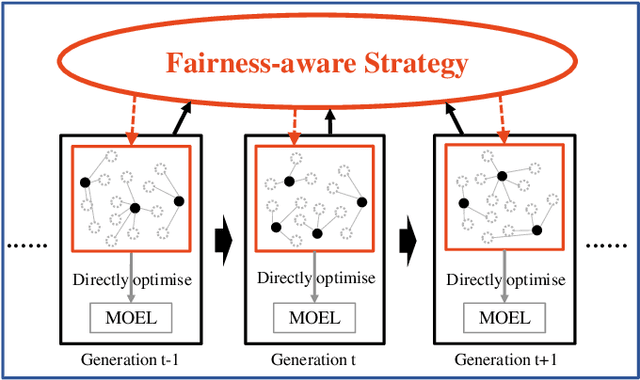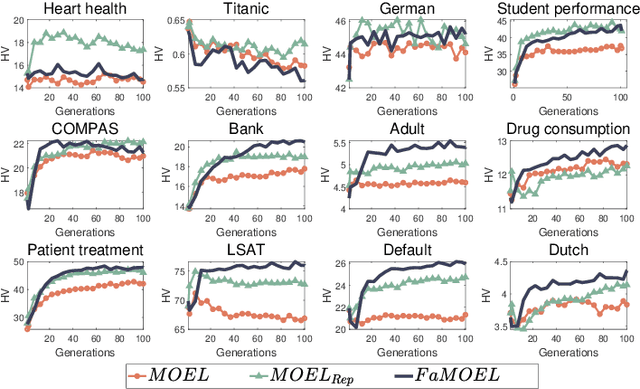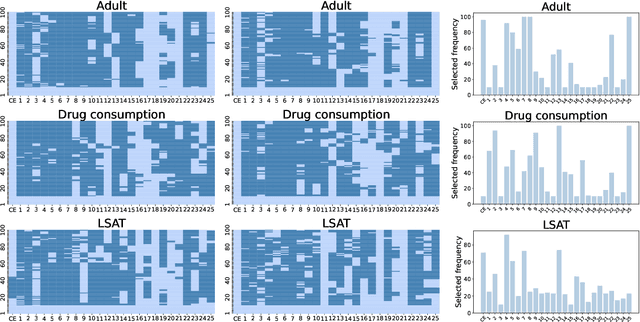Xin Yao
Guangdong Provincial Key Laboratory of Brain-inspired Intelligent Computation, Department of Computer Science and Engineering, Southern University of Science and Technology, Center of Excellence for Research in Computational Intelligence and Applications
Estimate Hitting Time by Hitting Probability for Elitist Evolutionary Algorithms
Jun 18, 2025Abstract:Drift analysis is a powerful tool for analyzing the time complexity of evolutionary algorithms. However, it requires manual construction of drift functions to bound hitting time for each specific algorithm and problem. To address this limitation, general linear drift functions were introduced for elitist evolutionary algorithms. But calculating linear bound coefficients effectively remains a problem. This paper proposes a new method called drift analysis of hitting probability to compute these coefficients. Each coefficient is interpreted as a bound on the hitting probability of a fitness level, transforming the task of estimating hitting time into estimating hitting probability. A novel drift analysis method is then developed to estimate hitting probability, where paths are introduced to handle multimodal fitness landscapes. Explicit expressions are constructed to compute hitting probability, significantly simplifying the estimation process. One advantage of the proposed method is its ability to estimate both the lower and upper bounds of hitting time and to compare the performance of two algorithms in terms of hitting time. To demonstrate this application, two algorithms for the knapsack problem, each incorporating feasibility rules and greedy repair respectively, are compared. The analysis indicates that neither constraint handling technique consistently outperforms the other.
AutoSchemaKG: Autonomous Knowledge Graph Construction through Dynamic Schema Induction from Web-Scale Corpora
May 29, 2025Abstract:We present AutoSchemaKG, a framework for fully autonomous knowledge graph construction that eliminates the need for predefined schemas. Our system leverages large language models to simultaneously extract knowledge triples and induce comprehensive schemas directly from text, modeling both entities and events while employing conceptualization to organize instances into semantic categories. Processing over 50 million documents, we construct ATLAS (Automated Triple Linking And Schema induction), a family of knowledge graphs with 900+ million nodes and 5.9 billion edges. This approach outperforms state-of-the-art baselines on multi-hop QA tasks and enhances LLM factuality. Notably, our schema induction achieves 95\% semantic alignment with human-crafted schemas with zero manual intervention, demonstrating that billion-scale knowledge graphs with dynamically induced schemas can effectively complement parametric knowledge in large language models.
MoE Parallel Folding: Heterogeneous Parallelism Mappings for Efficient Large-Scale MoE Model Training with Megatron Core
Apr 21, 2025Abstract:Mixture of Experts (MoE) models enhance neural network scalability by dynamically selecting relevant experts per input token, enabling larger model sizes while maintaining manageable computation costs. However, efficient training of large-scale MoE models across thousands of GPUs presents significant challenges due to limitations in existing parallelism strategies. We introduce an end-to-end training framework for large-scale MoE models that utilizes five-dimensional hybrid parallelism: Tensor Parallelism, Expert Parallelism, Context Parallelism, Data Parallelism, and Pipeline Parallelism. Central to our approach is MoE Parallel Folding, a novel strategy that decouples the parallelization of attention and MoE layers in Transformer models, allowing each layer type to adopt optimal parallel configurations. Additionally, we develop a flexible token-level dispatcher that supports both token-dropping and token-dropless MoE training across all five dimensions of parallelism. This dispatcher accommodates dynamic tensor shapes and coordinates different parallelism schemes for Attention and MoE layers, facilitating complex parallelism implementations. Our experiments demonstrate significant improvements in training efficiency and scalability. We achieve up to 49.3% Model Flops Utilization (MFU) for the Mixtral 8x22B model and 39.0% MFU for the Qwen2-57B-A14B model on H100 GPUs, outperforming existing methods. The framework scales efficiently up to 1,024 GPUs and maintains high performance with sequence lengths up to 128K tokens, validating its effectiveness for large-scale MoE model training. The code is available in Megatron-Core.
Procedural Fairness and Its Relationship with Distributive Fairness in Machine Learning
Jan 12, 2025Abstract:Fairness in machine learning (ML) has garnered significant attention in recent years. While existing research has predominantly focused on the distributive fairness of ML models, there has been limited exploration of procedural fairness. This paper proposes a novel method to achieve procedural fairness during the model training phase. The effectiveness of the proposed method is validated through experiments conducted on one synthetic and six real-world datasets. Additionally, this work studies the relationship between procedural fairness and distributive fairness in ML models. On one hand, the impact of dataset bias and the procedural fairness of ML model on its distributive fairness is examined. The results highlight a significant influence of both dataset bias and procedural fairness on distributive fairness. On the other hand, the distinctions between optimizing procedural and distributive fairness metrics are analyzed. Experimental results demonstrate that optimizing procedural fairness metrics mitigates biases introduced or amplified by the decision-making process, thereby ensuring fairness in the decision-making process itself, as well as improving distributive fairness. In contrast, optimizing distributive fairness metrics encourages the ML model's decision-making process to favor disadvantaged groups, counterbalancing the inherent preferences for advantaged groups present in the dataset and ultimately achieving distributive fairness.
Artificial Intelligence without Restriction Surpassing Human Intelligence with Probability One: Theoretical Insight into Secrets of the Brain with AI Twins of the Brain
Dec 04, 2024Abstract:Artificial Intelligence (AI) has apparently become one of the most important techniques discovered by humans in history while the human brain is widely recognized as one of the most complex systems in the universe. One fundamental critical question which would affect human sustainability remains open: Will artificial intelligence (AI) evolve to surpass human intelligence in the future? This paper shows that in theory new AI twins with fresh cellular level of AI techniques for neuroscience could approximate the brain and its functioning systems (e.g. perception and cognition functions) with any expected small error and AI without restrictions could surpass human intelligence with probability one in the end. This paper indirectly proves the validity of the conjecture made by Frank Rosenblatt 70 years ago about the potential capabilities of AI, especially in the realm of artificial neural networks. Intelligence is just one of fortuitous but sophisticated creations of the nature which has not been fully discovered. Like mathematics and physics, with no restrictions artificial intelligence would lead to a new subject with its self-contained systems and principles. We anticipate that this paper opens new doors for 1) AI twins and other AI techniques to be used in cellular level of efficient neuroscience dynamic analysis, functioning analysis of the brain and brain illness solutions; 2) new worldwide collaborative scheme for interdisciplinary teams concurrently working on and modelling different types of neurons and synapses and different level of functioning subsystems of the brain with AI techniques; 3) development of low energy of AI techniques with the aid of fundamental neuroscience properties; and 4) new controllable, explainable and safe AI techniques with reasoning capabilities of discovering principles in nature.
PFAttack: Stealthy Attack Bypassing Group Fairness in Federated Learning
Oct 09, 2024



Abstract:Federated learning (FL), integrating group fairness mechanisms, allows multiple clients to collaboratively train a global model that makes unbiased decisions for different populations grouped by sensitive attributes (e.g., gender and race). Due to its distributed nature, previous studies have demonstrated that FL systems are vulnerable to model poisoning attacks. However, these studies primarily focus on perturbing accuracy, leaving a critical question unexplored: Can an attacker bypass the group fairness mechanisms in FL and manipulate the global model to be biased? The motivations for such an attack vary; an attacker might seek higher accuracy, yet fairness considerations typically limit the accuracy of the global model or aim to cause ethical disruption. To address this question, we design a novel form of attack in FL, termed Profit-driven Fairness Attack (PFATTACK), which aims not to degrade global model accuracy but to bypass fairness mechanisms. Our fundamental insight is that group fairness seeks to weaken the dependence of outputs on input attributes related to sensitive information. In the proposed PFATTACK, an attacker can recover this dependence through local fine-tuning across various sensitive groups, thereby creating a biased yet accuracy-preserving malicious model and injecting it into FL through model replacement. Compared to attacks targeting accuracy, PFATTACK is more stealthy. The malicious model in PFATTACK exhibits subtle parameter variations relative to the original global model, making it robust against detection and filtering by Byzantine-resilient aggregations. Extensive experiments on benchmark datasets are conducted for four fair FL frameworks and three Byzantine-resilient aggregations against model poisoning, demonstrating the effectiveness and stealth of PFATTACK in bypassing group fairness mechanisms in FL.
Fairness-aware Multiobjective Evolutionary Learning
Sep 27, 2024



Abstract:Multiobjective evolutionary learning (MOEL) has demonstrated its advantages of training fairer machine learning models considering a predefined set of conflicting objectives, including accuracy and different fairness measures. Recent works propose to construct a representative subset of fairness measures as optimisation objectives of MOEL throughout model training. However, the determination of a representative measure set relies on dataset, prior knowledge and requires substantial computational costs. What's more, those representative measures may differ across different model training processes. Instead of using a static predefined set determined before model training, this paper proposes to dynamically and adaptively determine a representative measure set online during model training. The dynamically determined representative set is then used as optimising objectives of the MOEL framework and can vary with time. Extensive experimental results on 12 well-known benchmark datasets demonstrate that our proposed framework achieves outstanding performance compared to state-of-the-art approaches for mitigating unfairness in terms of accuracy as well as 25 fairness measures although only a few of them were dynamically selected and used as optimisation objectives. The results indicate the importance of setting optimisation objectives dynamically during training.
* 14 pages
PROUD: PaRetO-gUided Diffusion Model for Multi-objective Generation
Jul 05, 2024Abstract:Recent advancements in the realm of deep generative models focus on generating samples that satisfy multiple desired properties. However, prevalent approaches optimize these property functions independently, thus omitting the trade-offs among them. In addition, the property optimization is often improperly integrated into the generative models, resulting in an unnecessary compromise on generation quality (i.e., the quality of generated samples). To address these issues, we formulate a constrained optimization problem. It seeks to optimize generation quality while ensuring that generated samples reside at the Pareto front of multiple property objectives. Such a formulation enables the generation of samples that cannot be further improved simultaneously on the conflicting property functions and preserves good quality of generated samples. Building upon this formulation, we introduce the PaRetO-gUided Diffusion model (PROUD), wherein the gradients in the denoising process are dynamically adjusted to enhance generation quality while the generated samples adhere to Pareto optimality. Experimental evaluations on image generation and protein generation tasks demonstrate that our PROUD consistently maintains superior generation quality while approaching Pareto optimality across multiple property functions compared to various baselines.
An Interpretable Alternative to Neural Representation Learning for Rating Prediction -- Transparent Latent Class Modeling of User Reviews
Jul 02, 2024Abstract:Nowadays, neural network (NN) and deep learning (DL) techniques are widely adopted in many applications, including recommender systems. Given the sparse and stochastic nature of collaborative filtering (CF) data, recent works have critically analyzed the effective improvement of neural-based approaches compared to simpler and often transparent algorithms for recommendation. Previous results showed that NN and DL models can be outperformed by traditional algorithms in many tasks. Moreover, given the largely black-box nature of neural-based methods, interpretable results are not naturally obtained. Following on this debate, we first present a transparent probabilistic model that topologically organizes user and product latent classes based on the review information. In contrast to popular neural techniques for representation learning, we readily obtain a statistical, visualization-friendly tool that can be easily inspected to understand user and product characteristics from a textual-based perspective. Then, given the limitations of common embedding techniques, we investigate the possibility of using the estimated interpretable quantities as model input for a rating prediction task. To contribute to the recent debates, we evaluate our results in terms of both capacity for interpretability and predictive performances in comparison with popular text-based neural approaches. The results demonstrate that the proposed latent class representations can yield competitive predictive performances, compared to popular, but difficult-to-interpret approaches.
Learning Mixture-of-Experts for General-Purpose Black-Box Discrete Optimization
May 29, 2024Abstract:Real-world applications involve various discrete optimization problems. Designing a specialized optimizer for each of these problems is challenging, typically requiring significant domain knowledge and human efforts. Hence, developing general-purpose optimizers as an off-the-shelf tool for a wide range of problems has been a long-standing research target. This article introduces MEGO, a novel general-purpose neural optimizer trained through a fully data-driven learning-to-optimize (L2O) approach. MEGO consists of a mixture-of-experts trained on experiences from solving training problems and can be viewed as a foundation model for optimization problems with binary decision variables. When presented with a problem to solve, MEGO actively selects relevant expert models to generate high-quality solutions. MEGO can be used as a standalone sample-efficient optimizer or in conjunction with existing search methods as an initial solution generator. The generality of MEGO is validated across six problem classes, including three classic problem classes and three problem classes arising from real-world applications in compilers, network analysis, and 3D reconstruction. Trained solely on classic problem classes, MEGO performs very well on all six problem classes, significantly surpassing widely used general-purpose optimizers in both solution quality and efficiency. In some cases, MEGO even surpasses specialized state-of-the-art optimizers. Additionally, MEGO provides a similarity measure between problems, yielding a new perspective for problem classification. In the pursuit of general-purpose optimizers through L2O, MEGO represents an initial yet significant step forward.
 Add to Chrome
Add to Chrome Add to Firefox
Add to Firefox Add to Edge
Add to Edge